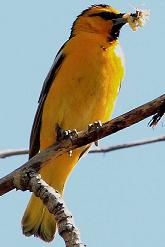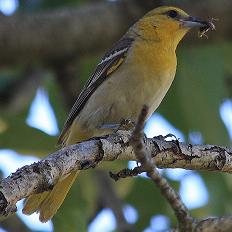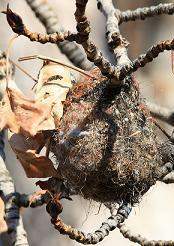Bullock's Oriole
Identification and Pictures
(Classification: Icterus bullockii)
 Bullock's
orioles are 7 to 8 1/2 inches, with a pointed bill, and a long
tail. The male is a striking bird, with bright yellow or
orange, and black plumage. The head has a black crown,
there is a black line through the eye, the throat, back, and
the wings are black, with white wing bars. Their legs
and feet are gray. The females, and young are olive-gray
to yellow above with yellow on the throat, and tail, and the
belly is paler. The wings are brown or grayish with 2
wing bars. Young males look like the female, but have a
black throat, and a black line through the eye. Bullock's
orioles are 7 to 8 1/2 inches, with a pointed bill, and a long
tail. The male is a striking bird, with bright yellow or
orange, and black plumage. The head has a black crown,
there is a black line through the eye, the throat, back, and
the wings are black, with white wing bars. Their legs
and feet are gray. The females, and young are olive-gray
to yellow above with yellow on the throat, and tail, and the
belly is paler. The wings are brown or grayish with 2
wing bars. Young males look like the female, but have a
black throat, and a black line through the eye.
Photos by Keith Lee. The camera I used is
the Canon EOS
40D and a 70 to 300 zoom lens.
Baltimore
oriole's colors are a little different, having more black than
Bullock's oriole.
Orchard orioles, another similar bird, looks more like the Baltimore
oriole but has darker under parts.
The Spot breasted Oriole looks like
the Baltimore except for an orange head, a black bib and
spots on the sides of the breast.
The Baltimore, and Bullock's oriole were once considered to be
one species, the Northern oriole. There are various
hybrid oriels where their ranges overlap.
Download an Oriole puzzle
Song and Sound
The song is a series of whistled notes and
rattles. Their call is a chatter with a low chirp.
Both male, and female sing similar songs but her song has a
harsher ending.
Listen to
Sound
Habitat and Range
Their summer range is western U.S. and Canada, and they
migrate to Mexico, and Central America for winter. They
can be found in open woods, trees along streams and rivers,
and residential areas.
Nesting and Breeding
 During
courting the male will rise up then bow repeatedly to the
female with his wings and tail raised. During
courting the male will rise up then bow repeatedly to the
female with his wings and tail raised.
The nest is a pouch hung from a branch, made with
grass, hair, twine, and wool, and lined with feathers, and
cotton from cottonwood or willow trees.
 The female will lay 3 to 6
blue or grayish white eggs, scrolled with purple or brownish
lines. She will incubate the eggs for about 2 weeks, and
the young birds will fledge in 2 more weeks. The young are fed by both parents. The female will lay 3 to 6
blue or grayish white eggs, scrolled with purple or brownish
lines. She will incubate the eggs for about 2 weeks, and
the young birds will fledge in 2 more weeks. The young are fed by both parents.
Food and Feeding
Natural foods are insects such as caterpillars, and ants,
spiders, blossoms,
fruit, berries, and nectar. Orioles forage in trees, and
shrubs. They can be attracted to bird feeders
with fruit, jellies, peanut butter, or suet. Orange
slices are a favorite, and they will also visit hummingbird feeders.
Like other backyard birds, Orioles love water. A good supply
of food and a fresh, clean, birdbath, will keep Bullocks'
oriole coming back.
For more on Food
and Feeding click here
 Oriole posters
Oriole posters
More Backyard
Bird Favorites

|
